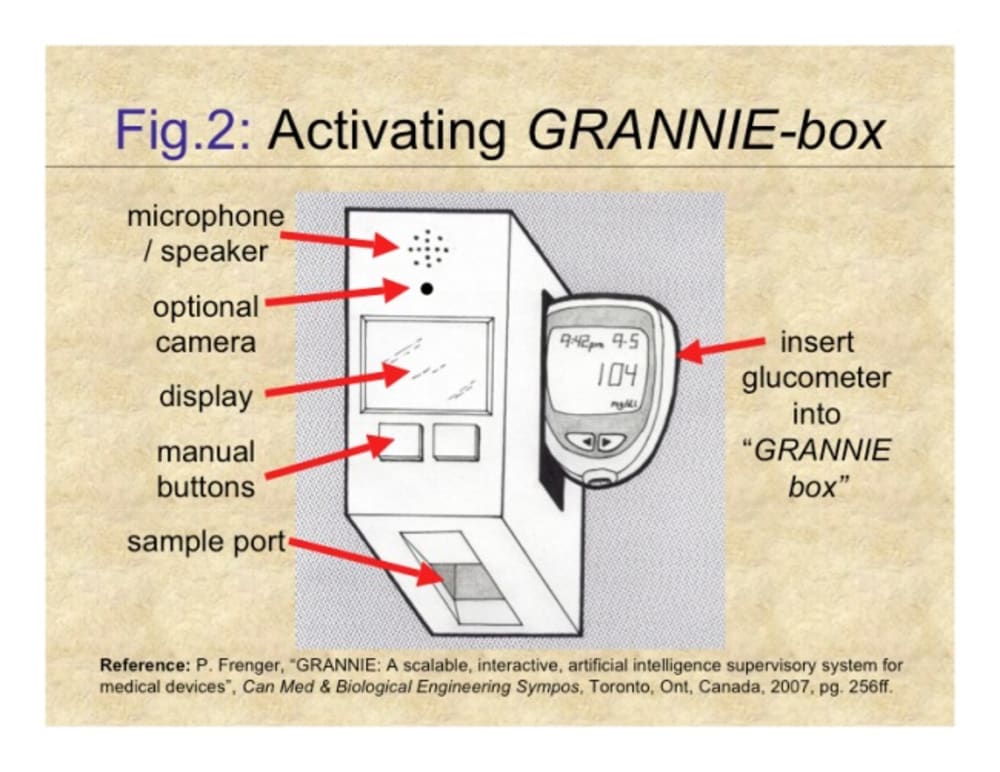In April, 2010 the FDA announced its “Home Use Initiative” to ensure that caregivers and patients can use complex medical devices in the home safely. In the spirit of this initiative, our GRANNIE-box (or G-box) device simplifies the use of a typical commercial home glucometer for diabetics: the Accu-Chek® by Roche.
This glucose meter is quite complex, for example having a display with 25 numeric / graphic items to learn (Figure 1), 24 error codes to understand and a 55 page user manual.
The G-box is a patient-friendly add-on device which provides new features for limited, non- modifiable commercial medical devices. G-box has many advantages. It facilitates proper operation by inexperienced users, thus promoting public safety. It minimizes painful fingersticks and reduces wasted test strips. It automates medical device tasks using computer technology and outstanding artificial intelligence (AI).
How does the G-box do this? It improves the glucometer interface: its touch-sensitive color LCD display has an unambiguous layout; it presses the glucometer buttons for you; and it works in several languages via its speech recognition / voice synthesizer. It extends glucometer functionality by improved handling and transmittal of data to health professionals, giving progress reports to patients, and providing alarms for abnormal glucose levels. Additional amenities include an onboard user manual and maintenance reminder. The most novel feature of the G-box is its AI: a realistic human-like personality and emotion processing, the GRANNIE who inspires patient trust, emotional bonding and cooperation.
Here's how the G-box works. Insert the glucometer into the side slot (see Figure 2. G-box components are depicted in Figure 3). The box overrides all glucometer functions. An internal camera reads the glucometer’s LCD display. A second outward-facing camera reads insulin vial barcode data and could perform user face recognition. Motorized or Nitinol contractile wire actuators press the glucometer buttons. Its microphone enables speech recognition; its speaker provides text-to-speech output. Its external LCD displays text, graphics or video. G-box's intelligence resides in a single board computer (SBC) with communication jacks, Wi-Fi or cellular wireless ports, and a PC-compatible SD/MMC data card.
The G-box’s market potential includes patients, clinics, doctors’ offices, the ER and hospitals. There is absolutely NOTHING like this on the market. The G-box approach could be readily adapted to medical devices other than glucometers.
As for manufacturing: a G-box prototype will be created for each medical device to be controlled, using a CAD-based toolkit and 3-D solid printing to adapt case configuration, components and layout. A software tool chain will be developed to write interface programs. Major G-box components will be designed for reusability. G-boxes will be sold through distributors and direct to consumers via the Internet. A “return exchange program” will allow recycling of useful components removed from used G-boxes, thus lowering life-cycle costs.
Status: the prototype has been simulated using one SBC as the G-box and another as the glucometer. All major subsystems have been tested. The remarkable GRANNIE artificial personality has been in development for the last 12 years.
Like this entry?
-
About the Entrant
- Name:Paul Frenger Md
- Type of entry:individual
- Software used for this entry:IMSAI TurboCAD, Autodesk Autosketch, Adobe Streamline, MPE Modular Forth, IEEE 1275-1994
- Patent status:none








